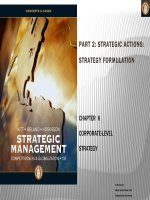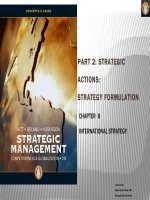Strategic management competitiveness globalization concepts and case 10e chapter 7
Bạn đang xem bản rút gọn của tài liệu. Xem và tải ngay bản đầy đủ của tài liệu tại đây (856.04 KB, 67 trang )
PART 1: STRATEGIC
MANAGEMENT INPUTS
CHAPTER 2
The External Environment: Opportunities,
Threats, Industry Competition, & Competitor
Analysis
Authored by:
Marta Szabo White. Ph.D
Georgia State University
THE STRATEGIC MANAGEMENT
PROCESS
©2013 Cengage Learning. All Rights Reserved. May not be copied, scanned, or duplicated, in whole or in part, except for use as permitted in a license distributed with a certain product or service or otherwise on a passwordprotected website for classroom use.
KNOWLEDGE OBJECTIVES
● Explain the importance of analyzing and understanding the
firm’s external environment.
● Define and describe the general environment and the industry
environment.
● Discuss the four activities of the external environmental
analysis process.
● Name and describe the general environment’s seven
segments.
©2013 Cengage Learning. All Rights Reserved. May not be copied, scanned, or duplicated, in whole or in part, except for use as permitted in a license distributed with a certain product or service or otherwise on a passwordprotected website for classroom use.
KNOWLEDGE OBJECTIVES
● Identify the five competitive forces and explain how they
determine an industry’s profit potential.
● Define strategic groups and describe their influence on the
firm.
● Describe what firms need to know about their competitors
and different methods (including ethical standards) used to
collect intelligence about them.
©2013 Cengage Learning. All Rights Reserved. May not be copied, scanned, or duplicated, in whole or in part, except for use as permitted in a license distributed with a certain product or service or otherwise on a passwordprotected website for classroom use.
IMPORTANT DEFINITIONS
A firm’s EXTERNAL ENVIRONMENT is broken down into
three parts:
● General
● Industry
● Competitor
A firm’s strategic actions are influenced by the conditions in all three
parts.
©2013 Cengage Learning. All Rights Reserved. May not be copied, scanned, or duplicated, in whole or in part, except for use as permitted in a license distributed with a certain product or service or otherwise on a passwordprotected website for classroom use.
IMPORTANT DEFINITIONS
● General Environment
MACRO
MACRO
Dimensions in the broader society that influence an industry and the
firms within it
● Industry Environment
Set of factors that directly influences a firm and its competitive
actions and response
MICRO
MICRO
● Competitor Environment
Focuses on each company against which a firm directly competes
©2013 Cengage Learning. All Rights Reserved. May not be copied, scanned, or duplicated, in whole or in part, except for use as permitted in a license distributed with a certain product or service or otherwise on a passwordprotected website for classroom use.
THE EXTERNAL ENVIRONMENT
FIGURE 2.1
The External Environment
©2013 Cengage Learning. All Rights Reserved. May not be copied, scanned, or duplicated, in whole or in part, except for use as permitted in a license distributed with a certain product or service or otherwise on a passwordprotected website for classroom use.
OPENING CASE
BRITISH PETROLEUM (BP)
External environment affects a firm’s strategic actions
●BP seeks to expand its oil reserves after the Deepwater Horizon oil and gas drilling
platform disaster in the Gulf of Mexico by forming joint ventures in Russia with Rosneft
Corporation and in India with Reliance Industries.
●BP’s strategic actions are also affected by conditions in other segments of its general
environment: e.g., the political/legal, social/cultural, and physical environment segments.
©2013 Cengage Learning. All Rights Reserved. May not be copied, scanned, or duplicated, in whole or in part, except for use as permitted in a license distributed with a certain product or service or otherwise on a passwordprotected website for classroom use.
THE EXTERNAL ENVIRONMENT
A
firm’s external environment creates:
● OPPORTUNITIES
e.g., the opportunity for BP to enter other global markets, and
● THREATS
e.g., the possibility that additional regulations in its markets will reduce opportunities for BP
to extract oil and gas
C ollectively, opportunities and threats affect a firm’s strategic actions.
©2013 Cengage Learning. All Rights Reserved. May not be copied, scanned, or duplicated, in whole or in part, except for use as permitted in a license distributed with a certain product or service or otherwise on a passwordprotected website for classroom use.
MA
TC
HI
NG
THE EXTERNAL ENVIRONMENT
©2013 Cengage Learning. All Rights Reserved. May not be copied, scanned, or duplicated, in whole or in part, except for use as permitted in a license distributed with a certain product or service or otherwise on a passwordprotected website for classroom use.
THE EXTERNAL ENVIRONMENT
GENERAL
●The General Environment is grouped into seven environmental
segments:
[1] Demographic
[2] Economic
[3] Political/Legal
[4] Sociocultural
[5] Technological
[6] Global
[7] Physical
●To successfully deal with uncertainty in the external environment and
achieve strategic competitiveness, firms must be aware of and understand
these segments.
©2013 Cengage Learning. All Rights Reserved. May not be copied, scanned, or duplicated, in whole or in part, except for use as permitted in a license distributed with a certain product or service or otherwise on a passwordprotected website for classroom use.
THE EXTERNAL ENVIRONMENT
GENERAL
● Firms cannot directly CONTROL the general environment’s segments.
● However, these segments influence the actions that firms take.
● Successful firms learn how to gather the information needed to understand
all segments and their implications for selecting and implementing the firm’s
strategies.
©2013 Cengage Learning. All Rights Reserved. May not be copied, scanned, or duplicated, in whole or in part, except for use as permitted in a license distributed with a certain product or service or otherwise on a passwordprotected website for classroom use.
THE EXTERNAL ENVIRONMENT
GENERAL SEGMENTS AND ELEMENTS
THE DEMOGRAPHIC SEGMENT
Demographic segments are commonly analyzed on a global basis because of their potential effects
across countries’ borders and because many firms compete in global markets.
Demographic Segment
•
Population size
•
Age structure
•
Geographic distribution
•
Ethnic mix
•
Income distribution
©2013 Cengage Learning. All Rights Reserved. May not be copied, scanned, or duplicated, in whole or in part, except for use as permitted in a license distributed with a certain product or service or otherwise on a passwordprotected website for classroom use.
THE EXTERNAL ENVIRONMENT
GENERAL SEGMENTS AND ELEMENTS
THE ECONOMIC SEGMENT
This segment refers to the nature and direction of the economy in which a firm competes or
may compete. Firms generally seek to compete in relatively stable economies with strong
growth potential. With globalization and the interconnectedness of nations, firms must scan,
monitor, forecast, and assess the health of their host nation and the health of the economies
outside their host nation.
Economic Segment
•
Inflation rates
•
Interest rates
•
Trade deficits or surpluses
©2013 Cengage Learning. All Rights Reserved. May not be copied, scanned, or duplicated, in whole or in part, except for use as permitted in a license distributed with a certain product or service or otherwise on a passwordprotected website for classroom use.
THE EXTERNAL ENVIRONMENT
GENERAL SEGMENTS AND ELEMENTS
THE POLITICAL/LEGAL SEGMENT
This segment represents how organizations and governments mutually try to influence each other, and how
firms try to understand these influences (current and projected) on their strategic actions.
Political/Legal Segment
•
Antitrust laws
•
Taxation laws
•
Deregulation philosophies
•
Labor training laws
•
Educational philosophies and policies
©2013 Cengage Learning. All Rights Reserved. May not be copied, scanned, or duplicated, in whole or in part, except for use as permitted in a license distributed with a certain product or service or otherwise on a passwordprotected website for classroom use.
THE EXTERNAL ENVIRONMENT
GENERAL SEGMENTS AND ELEMENTS
THE SOCIOCULTURAL SEGMENT
The sociocultural segment is concerned with a society’s attitudes and cultural values. Because attitudes
and values form the cornerstone of a society, they often drive demographic, economic, political/legal, and
technological conditions and changes.
Sociocultural Segment
•
Women in the workforce
•
Workforce
•
Diversity attitudes about the quality of work life
•
Shifts in work and career preferences
•
Shifts in product and service preference characteristics
©2013 Cengage Learning. All Rights Reserved. May not be copied, scanned, or duplicated, in whole or in part, except for use as permitted in a license distributed with a certain product or service or otherwise on a passwordprotected website for classroom use.
THE EXTERNAL ENVIRONMENT
GENERAL SEGMENTS AND ELEMENTS
THE TECHNOLOGICAL SEGMENT
Technological changes occur through new products, processes, and materials. The
technological segment includes the activities involved in creating new knowledge and
translating that knowledge into new outputs, products, processes, and materials. Given the
rapid pace of technological change and risk of disruption, it is vital for firms to study this
segment.
Technological Segment
•
Product innovations
•
New communication technologies
©2013 Cengage Learning. All Rights Reserved. May not be copied, scanned, or duplicated, in whole or in part, except for use as permitted in a license distributed with a certain product or service or otherwise on a password-
•
protected website for classroom use.
THE EXTERNAL ENVIRONMENT
GENERAL SEGMENTS AND ELEMENTS
THE GLOBAL SEGMENT
Markets and consumers are more global. This segment includes relevant new global markets, existing
markets that are changing, important international political events, and critical cultural and
institutional characteristics of global markets.
Global Segment
•
Important political events
•
Critical global markets
•
Newly industrialized countries
•
Different cultural and institutional attributes
©2013 Cengage Learning. All Rights Reserved. May not be copied, scanned, or duplicated, in whole or in part, except for use as permitted in a license distributed with a certain product or service or otherwise on a passwordprotected website for classroom use.
THE EXTERNAL ENVIRONMENT
GENERAL SEGMENTS AND ELEMENTS
THE PHYSICAL ENVIRONMENT
SEGMENT
Concerned with trends oriented to sustaining the world’s physical environment, firms
recognize that ecological, social, and economic systems interactively influence what
happens in this particular segment. This segment refers to potential and actual changes
in the physical environment and business practices that are intended to positively
respond to and deal with those changes.
Physical Environment Segment
•
•
•
•
•
•
•
Energy consumption
Practices used to develop energy sources
Renewable energy efforts
Minimizing a firm’s environmental footprint
Availability of water as a resource
Producing environmentally friendly products
Reacting to natural or man-made disasters
©2013 Cengage Learning. All Rights Reserved. May not be copied, scanned, or duplicated, in whole or in part, except for use as permitted in a license distributed with a certain product or service or otherwise on a passwordprotected website for classroom use.
THE EXTERNAL ENVIRONMENT
GENERAL SEGMENTS AND ELEMENTS
THE PHYSICAL ENVIRONMENT
SEGMENT
EXAMPLE
Strategic Focus: Firms’ Efforts to Take Care of the Physical
Environment in Which They Compete
● The examples noted in this Strategic Focus: Siemens AG, McDonald’s,
Procter & Gamble, and GE signify a growing commitment by firms around
the globe in response to emerging trends in the physical environment
segment.
● In addition to positively responding to the observed trends in this
segment of the general environment, there is some evidence that firms
engaging in these types of behaviors outperform those failing to do so.
● This emerging evidence suggests that these behaviors benefit
companies, their stakeholders, and the physical environment in which they
operate.
©2013 Cengage Learning. All Rights Reserved. May not be copied, scanned, or duplicated, in whole or in part, except for use as permitted in a license distributed with a certain product or service or otherwise on a passwordprotected website for classroom use.
EXTERNAL ENVIRONMENTAL ANALYSIS
External environments are :
•
•
•
•
•
•
Turbulent
•
Firms engage in external environmental analysis to better
understand and cope with their environments.
•
This analysis has four parts:
Complex
Global
Uncertain
Ambiguous
Incomplete
scanning, monitoring, forecasting, and assessing .
©2013 Cengage Learning. All Rights Reserved. May not be copied, scanned, or duplicated, in whole or in part, except for use as permitted in a license distributed with a certain product or service or otherwise on a passwordprotected website for classroom use.
EXTERNAL ENVIRONMENTAL ANALYSIS
ing
ly z
the
l
rn a
e
t
ex
is a
nt
e
m
t
ron
i
v
, ye
t
l
en
cu
t,
dif
can
f
i
n
sig
y.
ivit
t
c
a
A na
©2013 Cengage Learning. All Rights Reserved. May not be copied, scanned, or duplicated, in whole or in part, except for use as permitted in a license distributed with a certain product or service or otherwise on a passwordprotected website for classroom use.
EXTERNAL ENVIRONMENTAL ANALYSIS
● Identifying opportunities and threats is an important objective of
studying the general environment.
● OPPORTUNITY is a condition in the general environment that if
exploited effectively, helps a company achieve strategic
competitiveness.
EXAMPLE: Procter & Gamble (P&G) is reorienting beauty products to better
serve both men and women.
©2013 Cengage Learning. All Rights Reserved. May not be copied, scanned, or duplicated, in whole or in part, except for use as permitted in a license distributed with a certain product or service or otherwise on a passwordprotected website for classroom use.
EXTERNAL ENVIRONMENTAL ANALYSIS
● THREAT is a condition in the general environment that may
hinder a company’s efforts to achieve strategic competitiveness.
EXAMPLE: Microsoft is experiencing a severe external threat as
smartphones are expected to surpass personal computer (PC) sales in the
near future.
©2013 Cengage Learning. All Rights Reserved. May not be copied, scanned, or duplicated, in whole or in part, except for use as permitted in a license distributed with a certain product or service or otherwise on a passwordprotected website for classroom use.
EXTERNAL ENVIRONMENTAL ANALYSIS
Firms use several sources to analyze the general
environment:
trade publications
newspapers
business publications
academic research
public polls
trade shows
suppliers
customers
employees
People in boundary-spanning positions can obtain a great
deal of this type of information.
Examples: salespersons, purchasing managers, public
relations directors, and customer service representatives, each
of whom interacts with external constituents
©2013 Cengage Learning. All Rights Reserved. May not be copied, scanned, or duplicated, in whole or in part, except for use as permitted in a license distributed with a certain product or service or otherwise on a passwordprotected website for classroom use.









